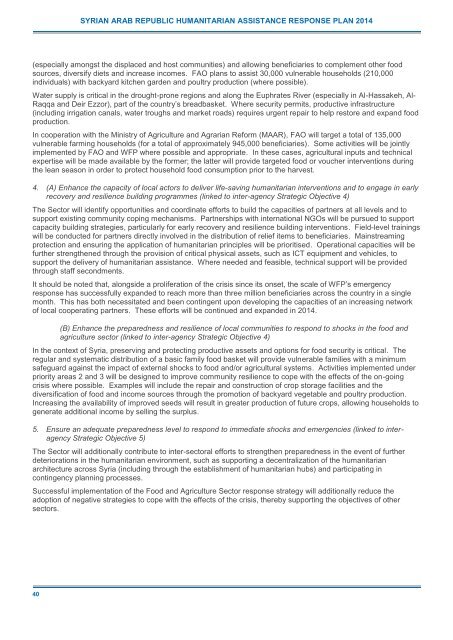2014 Syrian Arab Republic Humanitarian Assistance Response Plan (SHARP)
- No tags were found...
You also want an ePaper? Increase the reach of your titles
YUMPU automatically turns print PDFs into web optimized ePapers that Google loves.
SYRIAN ARAB REPUBLIC HUMANITARIAN ASSISTANCE RESPONSE PLAN <strong>2014</strong><br />
(especially amongst the displaced and host communities) and allowing beneficiaries to complement other food<br />
sources, diversify diets and increase incomes. FAO plans to assist 30,000 vulnerable households (210,000<br />
individuals) with backyard kitchen garden and poultry production (where possible).<br />
Water supply is critical in the drought-prone regions and along the Euphrates River (especially in Al-Hassakeh, Al-<br />
Raqqa and Deir Ezzor), part of the country‟s breadbasket. Where security permits, productive infrastructure<br />
(including irrigation canals, water troughs and market roads) requires urgent repair to help restore and expand food<br />
production.<br />
In cooperation with the Ministry of Agriculture and Agrarian Reform (MAAR), FAO will target a total of 135,000<br />
vulnerable farming households (for a total of approximately 945,000 beneficiaries). Some activities will be jointly<br />
implemented by FAO and WFP where possible and appropriate. In these cases, agricultural inputs and technical<br />
expertise will be made available by the former; the latter will provide targeted food or voucher interventions during<br />
the lean season in order to protect household food consumption prior to the harvest.<br />
4. (A) Enhance the capacity of local actors to deliver life-saving humanitarian interventions and to engage in early<br />
recovery and resilience building programmes (linked to inter-agency Strategic Objective 4)<br />
The Sector will identify opportunities and coordinate efforts to build the capacities of partners at all levels and to<br />
support existing community coping mechanisms. Partnerships with international NGOs will be pursued to support<br />
capacity building strategies, particularly for early recovery and resilience building interventions. Field-level trainings<br />
will be conducted for partners directly involved in the distribution of relief items to beneficiaries. Mainstreaming<br />
protection and ensuring the application of humanitarian principles will be prioritised. Operational capacities will be<br />
further strengthened through the provision of critical physical assets, such as ICT equipment and vehicles, to<br />
support the delivery of humanitarian assistance. Where needed and feasible, technical support will be provided<br />
through staff secondments.<br />
It should be noted that, alongside a proliferation of the crisis since its onset, the scale of WFP‟s emergency<br />
response has successfully expanded to reach more than three million beneficiaries across the country in a single<br />
month. This has both necessitated and been contingent upon developing the capacities of an increasing network<br />
of local cooperating partners. These efforts will be continued and expanded in <strong>2014</strong>.<br />
(B) Enhance the preparedness and resilience of local communities to respond to shocks in the food and<br />
agriculture sector (linked to inter-agency Strategic Objective 4)<br />
In the context of Syria, preserving and protecting productive assets and options for food security is critical. The<br />
regular and systematic distribution of a basic family food basket will provide vulnerable families with a minimum<br />
safeguard against the impact of external shocks to food and/or agricultural systems. Activities implemented under<br />
priority areas 2 and 3 will be designed to improve community resilience to cope with the effects of the on-going<br />
crisis where possible. Examples will include the repair and construction of crop storage facilities and the<br />
diversification of food and income sources through the promotion of backyard vegetable and poultry production.<br />
Increasing the availability of improved seeds will result in greater production of future crops, allowing households to<br />
generate additional income by selling the surplus.<br />
5. Ensure an adequate preparedness level to respond to immediate shocks and emergencies (linked to interagency<br />
Strategic Objective 5)<br />
The Sector will additionally contribute to inter-sectoral efforts to strengthen preparedness in the event of further<br />
deteriorations in the humanitarian environment, such as supporting a decentralization of the humanitarian<br />
architecture across Syria (including through the establishment of humanitarian hubs) and participating in<br />
contingency planning processes.<br />
Successful implementation of the Food and Agriculture Sector response strategy will additionally reduce the<br />
adoption of negative strategies to cope with the effects of the crisis, thereby supporting the objectives of other<br />
sectors.<br />
40



